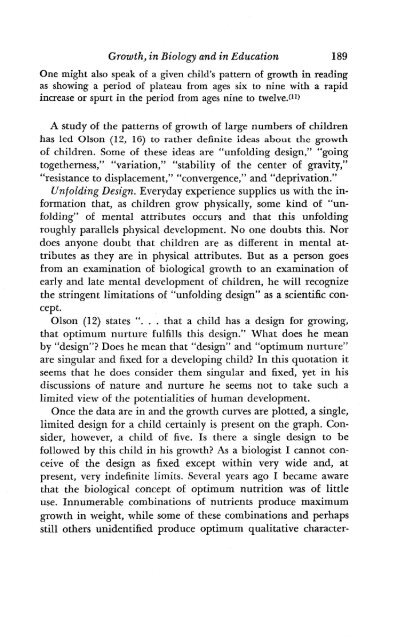Scientism and Values.pdf - Ludwig von Mises Institute
Scientism and Values.pdf - Ludwig von Mises Institute
Scientism and Values.pdf - Ludwig von Mises Institute
You also want an ePaper? Increase the reach of your titles
YUMPU automatically turns print PDFs into web optimized ePapers that Google loves.
Growth) in Biology <strong>and</strong> in Education 189<br />
One might also speak of a given child's pattern of growth in reading<br />
as showing a period of plateau from ages six to nine with a rapid<br />
increase or spurt in the period from ages nine to twelve.(ll)<br />
A study of the patterns of growth of large numbers of children<br />
has led Olson (12, 16) to rather definite ideas about the growth<br />
of children. Some of these ideas are "unfolding design," "going<br />
togetherness," "variation," "stability of the center of gravity,"<br />
"resistance to displacement," "convergence," <strong>and</strong> "deprivation."<br />
Unfolding Design. Everyday experience supplies us with the information<br />
that, as children grow physically, some kind of "unfolding"<br />
of mental attributes occurs <strong>and</strong> that this unfolding<br />
roughly parallels physical development. No one doubts this. Nor<br />
does anyone doubt that children are as different in mental attributes<br />
as they are in physical attributes. But as a person goes<br />
from an examination of biological gro,vth to an examination of<br />
early <strong>and</strong> late mental development of children, he will recognize<br />
the stringent limitations of "unfolding design" as a scientific concept.<br />
Olson (12) states "... that a child has a design for growing,<br />
that optimum nurture fulfills this design." What does he mean<br />
by "design"? Does he mean that "design" <strong>and</strong> "optimum nurture"<br />
are singular <strong>and</strong> fixed for a developing child? In this quotation it<br />
seems that he does consider them singular <strong>and</strong> fixed, yet in his<br />
discussions of nature <strong>and</strong> nurture he seems not to take such a<br />
limited view of the potentialities of human development.<br />
Once the data are in <strong>and</strong> the growth curves are plotted, a single,<br />
limited design for a child certainly is present on the graph. Consider,<br />
however, a child of five. Is there a single design to be<br />
followed by this child in his grovvth? As a biologist I cannot conceive<br />
of the design as fixed except within very wide <strong>and</strong>, at<br />
present, very indefinite limits. Several years ago I became aware<br />
that the biological concept of optimum nutrition was of little<br />
use. Innumerable combinations of nutrients produce maximum<br />
growth in weight, while some of these combinations <strong>and</strong> perhaps<br />
still others unidentified produce optimum qualitative character-
















